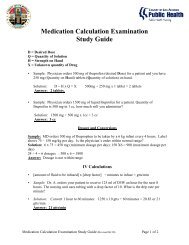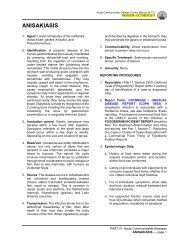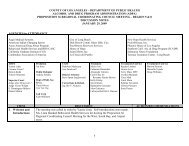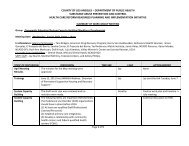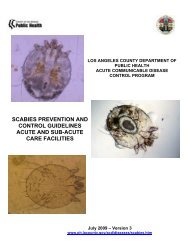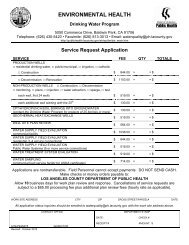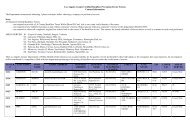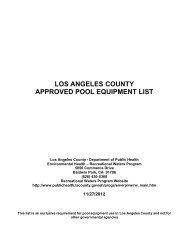Summary of the Safe Body Art Act - Department of Public Health ...
Summary of the Safe Body Art Act - Department of Public Health ...
Summary of the Safe Body Art Act - Department of Public Health ...
Create successful ePaper yourself
Turn your PDF publications into a flip-book with our unique Google optimized e-Paper software.
<strong>Body</strong> <strong>Art</strong><br />
<strong>Summary</strong> <strong>of</strong> <strong>the</strong> <strong>Safe</strong> <strong>Body</strong> <strong>Art</strong> <strong>Act</strong> cont.<br />
Clients Must Provide “Informed Consent”<br />
To provide informed consent clients must read and sign an informed consent form that<br />
includes a description <strong>of</strong> <strong>the</strong> procedure; a description <strong>of</strong> what to expect after <strong>the</strong><br />
procedure; a statement regarding <strong>the</strong> permanent nature <strong>of</strong> body art; and post procedure<br />
instructions including care <strong>of</strong> <strong>the</strong> procedure site, restrictions on physical activities, sign<br />
and symptoms <strong>of</strong> infection, and when to seek medical care.<br />
The informed consent form should also include a client health questionnaire to determine<br />
if <strong>the</strong> client is pregnant; has a history <strong>of</strong> herpes infection at <strong>the</strong> procedure site, diabetes,<br />
allergic reactions to latex or antibiotics, hemophilia or o<strong>the</strong>r bleeding disorder, or cardiac<br />
valve disease; has a history <strong>of</strong> medication use, including prescribed antibiotics prior to<br />
dental or surgical procedures; or has o<strong>the</strong>r risk factors for blood borne pathogen<br />
exposure.<br />
Requirements for <strong>Safe</strong> Performance <strong>of</strong> <strong>Body</strong> <strong>Art</strong><br />
• Wash and dry hands before beginning a procedure<br />
• Put on a clean apron, bib, or lap pad and personal protective equipment appropriate<br />
to <strong>the</strong> task<br />
• Put on clean, unused, disposable exam gloves just prior to <strong>the</strong> procedure and wear <strong>the</strong><br />
gloves throughout <strong>the</strong> procedure. Wash hands and change gloves if contact occurs<br />
with surfaces o<strong>the</strong>r than <strong>the</strong> client’s skin or instruments used in <strong>the</strong> procedure or if<br />
glove is punctured or torn<br />
• Apply antiseptic, antimicrobial, or microbicide to <strong>the</strong> client’s skin immediately prior<br />
to <strong>the</strong> procedure<br />
• Use a single-use razor to shave client and dispose <strong>of</strong> <strong>the</strong> razor in <strong>the</strong> sharps container<br />
• Only single-use needles and needle bars may be used and must be disposed <strong>of</strong> in <strong>the</strong><br />
“Sharps” container<br />
• Any part <strong>of</strong> a tattooing machine that may be touched by a practitioner during <strong>the</strong><br />
procedure shall be covered with a disposable plastic sheath that is discarded upon<br />
completion <strong>of</strong> <strong>the</strong> procedure<br />
• Instruments o<strong>the</strong>r than needles and needle bars that contact skin must be ei<strong>the</strong>r<br />
single use or be washed, disinfected, packaged, and sterilized after each procedure<br />
• Jewelry inserted in newly pierced skin must be made <strong>of</strong> approved materials<br />
• Only commercially manufactured inks, dyes, and pigments may be used and must be<br />
dispensed in a manner to prevent contamination <strong>of</strong> <strong>the</strong> storage container and<br />
remaining contents<br />
• After <strong>the</strong> procedure, wash and disinfect instruments and decontaminate <strong>the</strong><br />
workstation and procedure area<br />
• No food, drink, tobacco product, or personal effects are permitted in <strong>the</strong> procedure<br />
area<br />
• Animals, except service animals as defined by <strong>the</strong> ADA, are not permitted in <strong>the</strong><br />
procedure area or decontamination- sterilization area.<br />
Decontamination and Sterilization Requirements<br />
• Each instrument peel-packs must have an appropriate indicator<br />
• Each sterilization load shall be monitored with a Class V integrator<br />
• Sterilization units are to be loaded, operated, decontaminated, and maintained<br />
according to manufacturer specifications<br />
• A written log <strong>of</strong> each sterilization cycle including date, contents, exposure time<br />
and temperature and <strong>the</strong> results <strong>of</strong> <strong>the</strong> Class V integrator must be retained<br />
onsite for two years.<br />
• Sterilization packs must be inspected prior to storage and again prior to use.<br />
An Infection Prevention and<br />
Control Plan:<br />
� Specifies <strong>the</strong> procedures to<br />
achieve compliance with <strong>the</strong> <strong>Safe</strong><br />
<strong>Body</strong> <strong>Art</strong> <strong>Act</strong><br />
� Must be revised when changes are<br />
made in infection prevention<br />
practices, procedures, or tasks<br />
� Must include staff training upon<br />
initial assignment <strong>of</strong> task,<br />
whenever procedures change and<br />
not less than once per year<br />
� Include records <strong>of</strong> training on <strong>the</strong><br />
plan for <strong>the</strong> last three years<br />
An Infection Prevention and<br />
Control Plan must include <strong>the</strong><br />
following procedures:<br />
• Decontaminating and<br />
disinfecting surfaces<br />
• Decontaminating, packaging,<br />
and sterilizing reusable<br />
instruments<br />
• Protecting clean equipment and<br />
sterile instruments<br />
• Set up and tear down for any<br />
form <strong>of</strong> body art performed at<br />
<strong>the</strong> facility<br />
• <strong>Safe</strong> handling and disposal <strong>of</strong><br />
sharps waste<br />
• Preventing contamination <strong>of</strong><br />
instruments or procedure site<br />
during <strong>the</strong> performance <strong>of</strong> body<br />
art<br />
ENFORCEMENT<br />
Registrations and Licenses may be<br />
suspended for imminent health<br />
hazards. Registrations and Licenses<br />
may be suspended or revoked for<br />
serious or repeated violations after a<br />
hearing.<br />
Operating without a license or<br />
registration is a misdemeanor and is<br />
also subject to a penalty <strong>of</strong> three times<br />
<strong>the</strong> cost <strong>of</strong> <strong>the</strong> license or registration.<br />
Violations <strong>of</strong> <strong>the</strong> act are subject to an<br />
administrative penalty <strong>of</strong> $25-$1,000.<br />
If you have any questions, call <strong>the</strong> <strong>Body</strong> <strong>Art</strong> Program at (626) 430-5570 Revised 11/11/2012



